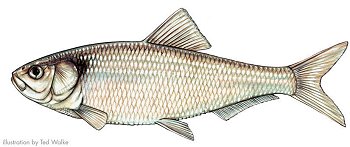
ALEWIFE
Alosa pseudoharengus

Species overview: The alewife is an anadromous herring in its natural
range, living its adult life in salt water and swimming into freshwater tributaries
to spawn. Its original distribution was along the Atlantic Coast, from South
Carolina northward into Canada. As a food fish for larger game fish, alewives
have also been stocked in impoundments across the state. They have also been
accidentally spread as escapees from fishermen’s bait buckets.
Its small size, large schools and availability to openwater game fish have made
the alewife suited for stocking in some inland reservoirs as a forage fish.
Identification: On the exterior, the alewife is nearly identical
to the closely related blueback herring. The surest difference is inside the
fish. The alewife has a silver-gray lining (peritoneum) to its body cavity.
The blueback’s peritoneum is black. Alewives are bluish green or bluish
gray on the back, silvery on the sides, with faint, dark stripes. They have
a large eye that is wider than the distance between the front of the snout to
the front of the eye. Like the blueback herring, alewives have a single dark
spot behind the upper gill cover, and the rear edge of the upper jaw extends
to the middle of the eye. The alewife’s lower jaw does not project noticeably
beyond the upper jaw. Like the American shad, the alewife has a deep notch in
its upper jaw. Saltwater alewives seldom weigh over one pound. Their maximum
length is 12 to 15 inches. Landlocked freshwater alewives rarely go more than
nine inches. The usual size is three to six inches.
Habits: Alewives can live in both fresh and salt water. Coastal
marine fish, they enter freshwater tributary rivers seasonally to spawn, negotiating
rapids and fishways to gain access upstream on their migration. Alewives can
also spend their lives entirely in cool, freshwater lakes, reproducing successfully
and becoming extremely abundant. Alewives are pelagic, schooling and feeding
in midwater or at the surface, over any bottom type.
Life history: Alewives spawn about two or three weeks earlier in the
spring than the American shad. They migrate upstream in April and May from the
mouths of rivers and creeks that open to the ocean into the freshwater flows.
They spawn in quiet areas with slow current or in still pools, randomly releasing
their minute, sticky eggs over the rocks, pebbles or other bottom material.
After spawning, the adults return to the stream mouth and may live in the shallow
estuary until fall, before going back to the ocean for the winter.
In April, the landlocked alewife in large freshwater lakes moves from its deepwater
habitat toward shore to spawn in the shallow water along beaches and on shoals.
Spawning occurs day or night from June through August, but normally peaks in
mid-July. After spawning, the school of adult alewives retreats to deep water.
The eggs sink to the bottom, and develop and hatch on their own. Landlocked
alewife females can spawn 10,000 to 22,000 eggs, while the larger oceangoing
alewives can produce up to 100,000 minute eggs.
Young alewives reach two or three inches long their first year. The males spawn
at two years old, the females at three. They eat zooplankton and other tiny
water organisms, some crustaceans, shrimp, small fishes and fish eggs. Even
as adults, alewives are able to feed extensively on zooplankton, because the
gill rakers that filter the microscopic food from the water increase in number
as the fish grow. They are not always a welcome addition to a lake because they
compete with the young of other fishes for food and they eat larval fish.